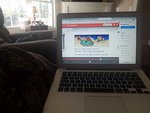

SILER CITY — The campus of Jordan-Matthews High School in Siler City, home to more than 870 students during a normal weekday, was silent on Wednesday.
But that doesn’t mean work wasn’t still being done.
Sidelined from their normal learning hub by the spread of COVID-19 — the novel coronavirus — and a state mandate to close all schools but still keep educating, Jordan-Matthews Principal Tripp Crayton, the 2020 Chatham County Schools Principal of the Year, and biology teacher Jessica Sandel were still doing their jobs, though under very unusual circumstances.
“Not a bit,” Crayton said, responding to a question about how much of his schooling prepared him for this. “This is probably the most challenging experience I’ve dealt with. There’s a lot of gray, and I like things in black and white.”
In his 14th year as a principal, Crayton said he’s trying to balance keeping his students and faculty both academically engaged and emotionally “OK” during this odd time. Sandel said she’s trying to do the same.
“It’s not even so much about making sure the kids know biology, it’s checking on them to make sure they’re OK,” said Sandel, who is both the 2014-2015 Jordan-Matthews Teacher of the Year and winner of the 2016 Lucrecia Herr Biology Teacher Award from the Association of Southeastern Biologists. “This is a huge shift for their norm and their structure. Them being home and not being able to see anybody, it’s crazy. We’re also just checking on them as a person. That’s probably 50 percent of this.”
A ‘new’ set of standards
On March 27, the state Department of Public Instruction instituted new guidance for public schools across the state, “strongly encourag(ing)” remote learning, defined as “learning that takes place outside of the traditional school setting using various media and formats, such as but not limited to: video conference, telephone conference, print material, online material, or learning management systems.”
The best kind of remote learning, the state guidance advises, is “accessible” by all students, meets curricular needs and “considers the whole child as well as the home learning environment.”
What that actually looks like in practice can depend on several things, including how prepared a district is for getting learning materials ready and having devices to receive that material.
Amanda Hartness, CCS’ assistant superintendent for the Academic Services & Instructional Support Division, said Chatham was prepared, even though it has been a shift.
“I would definitely say it’s been an adjustment, for some teachers more than others. I think Chatham’s ahead of the curve,” Hartness said. “As I look to neighboring counties and other surrounding districts, some of them still don’t have their remote learning plans up and running. We have provided families with devices for K-12, and many districts don’t have the capacity for that.”
But that planning and device capacity does not preclude the district and its schools from answering tough questions. On that “whole child” part of the DPI guidance —the state has been emphasizing in recent years educating every part of a student, including their social and emotional skills. As Sandel said, that becomes more difficult in a distance learning environment. Crayton said he’s been emphasizing to his teachers the need to check in on students beyond their academics.
“Making sure the kids are OK, they’ve got what they need — and if they don’t, they can reach out to our counseling staff and our social worker,” Crayton said. “It goes further than the academic piece. I’m fairly confident that (teachers are) doing everything they can to make sure they’ve seen or heard from every kid.”
Sandel said she’s brought home components of her school lab so she can do experiment demonstrations for students through Zoom meetings. After spring break, she’ll teach her students the parts of a microscope and how to use it. But doing that while trouble-shooting issues with remote learning software and answering questions just like any other day in class, she said, requires a lot.
“A lot of it is, ‘OK, I’ve got to figure this out,’” Sandel said “It’s been hours and hours and hours spent, ‘How do I make this work?’ Not just in an online environment but for EC [Exceptional Children] kids, and English language learners, and honors kids. It’s meeting the needs of the students that we have in our classroom. It’s been a lot of time.”
Accessibility for all
Grading is still allowed for assignments during this time in North Carolina public schools — if “critical factors” are met. That includes making sure the remote learning tools are “accessible by all students for which the learning is intended and is responsive to diverse learning groups,” according to the DPI guidance. But in Chatham, as in many other places, that’s a barrier.
According to the 2018 Chatham County Community Assessment, less than 60 percent of Chatham residents reported having “good quality internet,” with “stark differences in quality across the county.” For example, 44 percent of residents in western Chatham felt they had “good quality internet,” compared to two-thirds in the eastern part of Chatham.
This lack of broadband access across the county has been addressed by county leaders many times, with particularly prescient words spoken by County Manager Dan LaMontagne at a February 28 breakfast with Chatham’s elected officials, government leaders and legislative representatives.
“It’s extremely valuable to our students,” he said. “Their homework is increasingly online. This is really a needed utility throughout the state.”
This was 13 days before N.C. Governor Roy Cooper signed an executive order closing all the state’s public schools for two weeks, a period later extended to May 15.
Crayton estimates that around 90 kids, 18 percent of his school’s student population, don’t have internet access at all. The school has been making paper packets for students to provide them something to do, but even that has its limitations.
“The struggle with that, as you can probably imagine, is those kids are not getting any virtual face-to-face time,” Crayton said. “They’re having to learn on their own, figure things out on their own. If a teacher has 15 kids on paper packets, how does she communicate with them? Those are things we’re just having to work through and figure out how to make happen.”
Last year, the district made an agreement with the 1 Million Project, an initiative to bring internet hotspots free to needy students across America. Keith Medlin, the district’s director of technology & communications, said at the time that the hotspots can provide 10 free gigabytes of data a month, accounting for 900 emails, 900 webpage visits and 10 hours of instructional videos.
But picking up those hotspots was not mandatory, and as Crayton says, they don’t ensure broad equality in access.
“Just because a kid has a hotspot doesn’t mean they get equal access as those who have full internet,” Crayton said. “Hotspots can be slow. It counts on a student having cell service on their phone.”
Hartness said that achieving that kind of equality has been the district’s “biggest challenge” — “We do have students and staff who aren’t getting the same experience,” she said. And because of that, she said the county won’t meet all the critical factors to continue evaluations for all grade levels.
Making the most of it
There are a lot of groups facing particular challenges during this time.
The Class of 2020 is undergoing an abnormal senior year, as Crayton says: “We’re really concerned about them. Especially me. We know this is extremely hard for them. They don’t have a prom. We don’t know what’s going to happen for graduation. All these senior experiences they’re not getting, they’re facing a lot.”
Teachers who are parents, trying to manage their kids at home, as Sandel says, regarding her two kids: “I get up really early before they do to get a lot of stuff done. You try to get your kids going with something, and then once my school day, once my teaching day is over, I’m focusing more on my kids. They’re doing stuff more on the evenings and the weekends. We’re just doing the best that we can.”
The district and its schools are finding ways to make the most of it. If you go to Twitter and search “#CCSAtHome,” you’ll find a plethora of examples of how teachers are spending their time.
The Northwood High School Twitter account (@NHSChargers) posted a picture on April 1 of a teacher teaching about hydrogen using what looked like a child’s whiteboard. Siler City Elementary’s Twitter page (@SCEBulldogs) posted multiple pictures March 30 of students and teachers “DEAR”-ing (dropping everything and reading). And Becky Bouldin (@becky_bouldin), a special education teacher at Virginia Cross Elementary school, posted a photo of herself April 3 making videos for her students using Screencastify, with hashtags including #LearningANewTool and #SoSimpleToUse.
All this while still working with some uncertainty as to when school will resume. The governor’s most recent executive order says school will resume May 15.
“During the Great Depression, North Carolina’s leaders made sure that, because education was vital to our state’s future, all of our public schools stayed open in spite of tremendous funding challenges,” Cooper said during a March 23 press briefing. “In the spirit of that accomplishment, I am not ready to give up on this school year. However, we know that the effects of this pandemic will not subside any time soon.”
So in the meantime, the district is doing what it can. Hartness, Crayton and Sandel all say good has come out of this situation, mostly in how they understand Chatham’s students.
Hartness: “We’ve had teachers dabbling in all of these things, but I think we as educators sometimes underestimate what these kids are able to do. It’s reminded us sometimes that kids will meet the expectations that we set for them. We probably will have teachers that will utilize these digital platforms more.”
Crayton: “We live in world where we want answers now, and I’m the same way. This has caused me to slow down a lot and be patient and understanding of what our students are going through. It’s just a tough time for them. I really feel for the Class of 2020 right now.”
Sandel said students will often come into her classroom during a normal day with their earphones in, listening to music, almost shutting themselves off from the world. Now, with the world shutting them off from each other, they seem more ready to talk.
“I feel like I’ve gotten to know my students a little different,” she said. “They’re all answering how they are. Just emailing with the kids back and forth about what their day is like, how they’re doing. We’re getting to know them a little better.”
Reporter Zachary Horner can be reached at zhorner@chathamnr.com or on Twitter at @ZachHornerCNR.